Mercedes-Benz
|
1926 - Present |
Country: |
 |
|
When detailing the history of the magnificent Mercedes SL, it is appropriate that we look back a little further to the origins of the company, and what made it excel in the sports car arena. A more detailed
history of Mercedes Benz can be found on our
Unique Cars and Parts USA site, or, if you want to cut to the chase, skip forward to the heading "The Origins of the SL".
The annals of Daimler-Benz must be largely the history of the motor car. Inevitable -
Karl Benz and
Gottlieb Daimler being the joint inventors of the petrol-driven road vehicle, although this success was achieved separately. (They both lived in the province of Swabia, less than 60 km apart, and it is a strange fact that they hardly knew each other.) They founded the world's two original car companies, which merged in 1926.
Siegfried Markus
Of the generation before Benz and Daimler there was Siegfried Markus. He built four road vehicles with i.e. engines in Austria, and one of these is in the Vienna Museum and in running order! However, having satisfied himself that his invention would work, Markus lost all interest. It happened that, many years later, in the course of a lawsuit in America,
Henry Ford put forward the Markus patents to undermine an opponent's case.
The point is however, that, although motor vehicles that ran were built pre-Benz and pre-Daimler, these two remarkable men were the first to put the motor car on to a practical footing and go into production, and so they are rightly held to have been the true originators. The first car of Karl Benz ran in public in July 1886. It was a success and attained 9 mph. According to the present curator of the Daimler-Benz museum " ... Benz intended originally to build a four-wheel car, suitable steering system, and fell back on a three-wheeler".
The engine - 4-stroke, as the Otto patents had just expired - produced 1/3 of a hp at 250 to 300 rpm. (Later, at the Stuttgart Tech, College, this historic motor was tuned to achieve 0.88 hp and run to 400 rpm. The method of valve operation and the cooling arrangements were certainly primitive - a suction moved slide inlet valve and a mech. exhaust valve, and a water tank above the engine that acted as a radiator. But positioning the heavy flywheel of his one-cylinder engine, Benz chose the greater of two evils - a vertical flywheel affecting steering with a gyroscopic force, or a horizontal flywheel, from which would result a massive wobbling, swaying motion and great vibration (and would limit rpm to about 500!).
The Principle of Ignition
The second alternative, unfortunately, was chosen, and it inhibited future progress, but Benz was in advance of Damiler in the matter of ignition. The latter had adopted heated tubes, whereas Benz fired the mixture in his engine electrically, with a battery and trembler coil device and a
spark-plug. It was only when Bosch
ignition started to be used on the roads that Benz changed from his own production of these systems. Benz made his cars four-wheeled after the first two or three had been made. He predated Daimler in providing his cars with differentials instead of devices that gave a semi-declutching effect. Also, it was soon noticed that the cars of Benz were designed as such, and were not like those of Gottlieb Daimler, that were engines put into horse carriages with the shafts removed.
Frau Bertha Benz
An event that seems to have been less from the world of reality than from that of fantasy was the unofficial and quite secret drive by Frau Bertha Benz in the world's first car, the
prototype petrol-driven 3-wheeler. She took with her two young children, and while the previous longest distance ever covered had been about one km, she went off for 30 or 40 km, up and down numerous hills! All the same, this wildly improbable story is true, and also, one is aware of how the machine must have been far from simple to drive. For instance, the engine speed of 0 to 300 rpm had to be altered, not by a throttle, but a skilful tampering with the mixture. Lubrication was by frequent manual additions of oil, as the engine did not have an oil pump or a sump.
Benz and his company were riding high in the 1890s. In 1900, the export sales alone reached no less than 341, at the time a sensational figure! But soon troubles closed in on the company. The following year the public began to reject the dependable, but very slow, Benz cars, already looking antiquated. This can be best explained by stating that the problem was being caused by the off-beat ideas of the founder himself. dKarl Benz had concluded that the motor car was already in its final stage of development - in the same category as scissors, clothes-hangers and mousetraps. In his view, the cars of the 1920s or 1950s would be virtually the same as those of the 1890s.
By 1901, the firm of Benz had become the largest motor car producer, having turned out great quantities of vehicles with one-speed transmissions, upright steering, and no clutches, the engines engaging and disengaging by the running of a belt from a loose to a fixed pulley and vice-versa. Karl Benz declined to make any significant changes. He did not retire until 1903, at a time of open disagreement. Against the rebels within the firm he had held out because he had been made determined by the reliability of his old horseless-carriage design and the numbers of faithful, satisfied customers.
Julius Ganss and Marius Barbarou
His successor, Julius Ganss, then moved quickly, bringing in a team from France, led by Marius Barbarou, a respected designer and racing driver. The new models created were called "Benz Parcifals", the largest of them being 16/20 hp with four cylinders. Although they looked much like the Mercedes models of 1903, they had several obsolescent features such as non-mechanical inlet valves, and cooling by finned tubes. Like the small, slow, outdated cars of
Karl Benz, these also failed to sell. Surprisingly, Benz reappeared on the scene, and against his own inclinations and beliefs, but courageously, and showing common-sense, designed a vertical, 4-cylinder engine. M. Barbarou was the designer of the test of the car, and this proved a success, the company recovering from its crisis by late 1905.
It is also of interest that Benz, as late as 1914, was to be seen pottering about in one of his early horseless carriages. These were still being made as late as 1908. And he lived to be eighty-five years old. Concerning Mercedes, the car and the name, nearly everyone who has been interested in veteran car matters, is likely to have learned that the first Mercedes car was a type of Daimler, and that the name came from that of the young daughter of a wealthy banker, Emil Jellinek. In Southern France he was the Consul for the Empire of Franz-Josef, and he was also the agent for the Daimler company. Jellinek was more than a rich motor vehicle agent. He was a person with great influence, being a friend of millionaires, princes, counts, barons and English peers, and he was a racing driver and a director of the Daimler company.
The First Sports Car, The Daimler Phoenix
Between 1897 and 1900, Gottlieb Daimler and his associates had been producing a model, which in that very late Victorian period, was a kind of sports car. This was the front-engined "Daimler Phoenix". Its wheelbase was extra-short, it was high off the ground and it steered badly, an ominous set of features for a car used for racing. In 1900, a "Phoenix" crashed during the La Turbie hill climb and its driver was killed. The majority of the directors were strongly of the opinion that the Daimler company should no longer race. Out-voted were Emil Jellinek and Wilhelm Maybach. These men were persuasive, and as a result of a compromise proposal, the company continued in motor racing, with the cars concerned being called "Mercedes".
These cars followed a new design, created by Jellinek's supporter at the meeting, and Gottlieb's second-in-command, Maybach. The latter was later to become noted for his aircraft engines, and later still, in the 1930s, for being the maker of the splendid Maybach luxury car and the Lagonda's Maybach 8-speed gearbox. The first Mercedes, which was 35 hp, made its appearance in 1901, and the effect of this was formidable, as most of its rivals seemed to have been rendered obsolete. Describing it some years later, the company called it a revolutionary car, "combination of performance, good road-holding, steering, suspension and seating comfort."
The name was not German, but French-Spanish, a happy choice, and as intended, it assisted sales, for anti-German feelings, from the 1870-1 war, still lingered in France. The "Tour de Nice", 25th-29th March, 1901, was the occasion when these Mercedes cars were first seen - "Nice Week" as the speed trials were usually called, the leading motor sports event of the year. The Maybach-Jellinek unofficial Daimlers dominated all the events. At the hill-climb, for instance, a driver averaged 31.9 mph, as against the best time of 1900 of 19.5, recorded by a Daimler "Phoenix". A flying km was covered at 53.5 mph - amazing, and far in excess of what had been considered possible. Spectators were also staggered, when they saw that, after about 15 minutes work, the racing cars had been converted into elegant tourers with four comfortable seats!
Phasing Out The Name Daimler
These sensations, of course, caused the overnight establishment of the
Mercedes marque. The name, Daimler, was phased out in France, Belgium, Hungary and the U.S.A. Gottlieb Daimler had died in 1900, and the name changing process continued in other countries. Daimler cars were, however, sold as such in Britain, and later the English company became independent. The same thing happened in the case of the central European company, Austro-Daimler Gesellschaft. After the year of the merger of Mercedes and Benz, 1926, the name Daimler-Benz became general for most engine and vehicle operations, and most road vehicles were called Mercedes-Benz.
During the next year, 1902, Mercedes did not do well in racing. There was a comeback by French cars in the main sporting events, the most successful of these being Mors. However, the Mercedes order books were so full that a successful racing season would have only caused problems. I can mention that at this time, Emil Jellimek was having no trouble making use of his social connections. Among "Nice Week" drivers and pit crew for Mercedes were Prince Lubecki, Graf von Stern and Baron Henri de Rothschild. The reasons for the success of the first Mercedes - apart from publicity and the new, non-horseless-carriage profile, which of course, improved its roadability, were a number of features, rather startling for the year 1901 - mechanical inlet valves, radiators of honeycomb tyre with header tanks, gate gear changes and pressed steel frames.
A Revolutionary Radiator
The positively operated inlet valves replaced their movement by pressure and suction - called at the time "automatic" - and this made possible more exact valve timing and thus greater engine power. Students of motor design were greatly amazed by the Mercedes radiator, which did not feature a finned tube, shaped like a "jumping jack" firework. Instead, there was a header tank above a honeycomb device that possessed 8070 small channels. The company has commented that it still characterises the radiators of the M. Benz models of today, and ". . . it completely solved the problem of engine cooling." It certainly made possible engines of high output. Only 9 litres of water was needed, involving a massive saving of weight.
Compared to the previously used "quadrant" gear change, the "gate" gear change was a great step forward. I have driven a car with a Quadrant system, an Edwardian Clement-Bayard, and can say that a gate gear change is much superior. These cars were also the first to have pressed-steel frames, another successful feature, greatly adopted elsewhere. 1902 was the first year of the "Mercedes-Simplex", long and low by the standards of the time, with a more powerful 40 hp engine. It was to enjoy great popularity.
 Who would have guessed the
Benz Viktoria would lead to such wonderful classics
as the Mercedes SL and SLC's.
Who would have guessed the
Benz Viktoria would lead to such wonderful classics
as the Mercedes SL and SLC's.
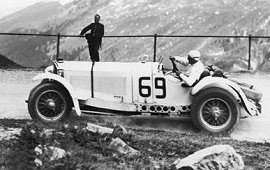 The SSKL with chassis drill
holes, the engineers would find any way to make
it faster.
The SSKL with chassis drill
holes, the engineers would find any way to make
it faster.
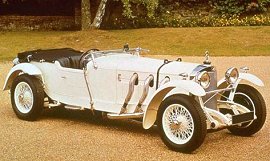 Good for 225bhp, but only
33 would be built.
Good for 225bhp, but only
33 would be built.
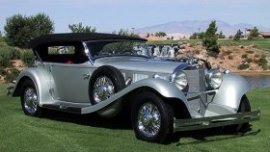 The overhead valve straight
eight engine of the 540K, while perfectly suited
to autobahn conditions, did not favour the Nurburgring. The overhead valve straight
eight engine of the 540K, while perfectly suited
to autobahn conditions, did not favour the Nurburgring.
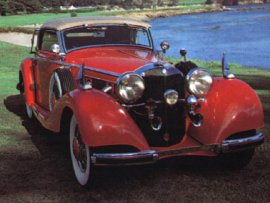 Compare the two images above,
and notice what a huge difference both colour
and white-wall tyres make to the sporting pretensions
of the 540K. Compare the two images above,
and notice what a huge difference both colour
and white-wall tyres make to the sporting pretensions
of the 540K.
 The 300SL "Gullwing",
a purists dream.
The 300SL "Gullwing",
a purists dream.
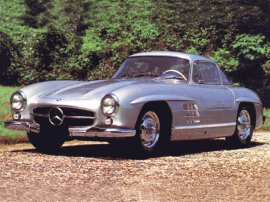 The quintessential object
of desire.
The quintessential object
of desire.
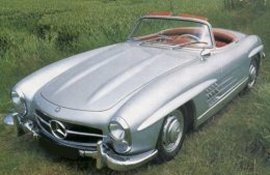 The 300SL Roadster allowed
women a more dignified way of entering and exiting
the vehicle.
The 300SL Roadster allowed
women a more dignified way of entering and exiting
the vehicle.
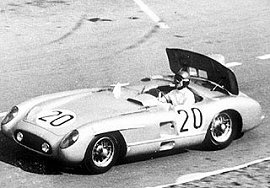 Unlike the Jaguar D-Type,
the Mercedes 300SLR relied on drum brakes. And,
of course, the revolutionary 'Air Wing'.
Unlike the Jaguar D-Type,
the Mercedes 300SLR relied on drum brakes. And,
of course, the revolutionary 'Air Wing'.
 The 190SL marked Mercedes
entry into the competitive sports car market,
till then dominated by the likes of Austin Healey
and Jaguar.
The 190SL marked Mercedes
entry into the competitive sports car market,
till then dominated by the likes of Austin Healey
and Jaguar.
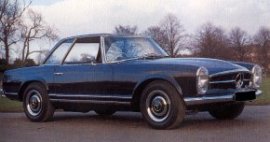 The pretty 230SL, affectionately
known as the 'Pagoda' due to its inverted hard
top roof.
The pretty 230SL, affectionately
known as the 'Pagoda' due to its inverted hard
top roof.
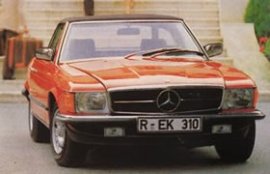 The R107 350SL quickly won
the respect of mechanics over the world with
its durability and reliability, earning it the
title 'Der Panzerwagen'.
The R107 350SL quickly won
the respect of mechanics over the world with
its durability and reliability, earning it the
title 'Der Panzerwagen'.
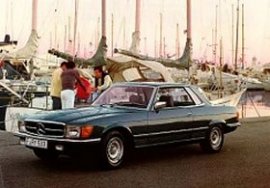 The R107 would re-introduce
the stylish coupe with the 350SLC, this time
as a 2+2.
The R107 would re-introduce
the stylish coupe with the 350SLC, this time
as a 2+2.
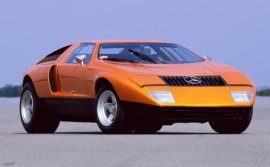 The Mercedes C111, the supercar
that never was.
The Mercedes C111, the supercar
that never was. |
The World's First Motor Launch
Although the aims of Gottlieb Daimler and Karl Benz, from 1886, had been identical, the methods they employed to achieve their objects were not the same. A main instance of this was the desire of Benz to provide the complete machine, whereas Daimler was more interested in adopting his engine to every kind of transport. Gottlieb Daimler moved fast. Before 1890, he had started the use of his 4-stroke petrol motor in street-cars, rail-cars, motor boats and the airship, that had been constructed by Karl Wolfert (1888). There was a Daimler engine for the world's first motor launch, the "Marie", of 23 ft. built for Prince Bismark and this also being 1888, this could have been the famous Iron Chancellor, but he could have been a son or nephew of the great statesman. At a regatta on the river, Main, at Frankfurt, Wilhelm Maybach, driving a motor boat was pursued by rowing-boats of police, Kaper Kop fashion. The water police lost face, and of course, the resulting publicity was of value.
Daimler said at the time that the marine use of his engine was a major factor in reducing the prejudice against the use of petrol as a fuel. It is an interesting point that multi-cylinder i.e. engines were first introduced mainly for use in boats. The first fourteen years of the century showed steady progress in the design and the quality of Mercedes, the firm earning the respect of the world and increasing in prosperity. The "modern" features and the successes of the 1901 Mercedes cars in the Tour de Nice had caused the President of the Automobile Club of France to become greatly excited. With a lot of emotion, he had stated, "We are now in the era of the Mercedes". In 1985, the company is still riding very high indeed, and we are still, it seems, well within the Mercedes era.
The Nice Week Cars
The best rpm figure for the Nice Week cars was 1000, and 35 hp came from engines of 5.9 litres. Today, a brisk idling speed, but then it was impressive, for preventing high engine speeds were the lack of a centre main bearing on a 4-cylinder engine, primitive pistons and archaic ideas about valves and valve timing. 35 hp from a 5.9 litre engine was not bad, for some years later the 7 litre Rolls-Royce engine was turning out 48 hp. As time passed, Maybach's designs achieved more power, not from larger and larger engines (ref. many rival makes of cars), but by creating more efficient reasonably small motors.
In 1903, Camille Jenatzy won a
Gordon Bennett race, driving a Mercedes. This was a standard touring car, the intended Mercedes racing cars having been destroyed in a fire. It was a piece of history that was later questioned - but unfairly, for about 60 years later, a vintage car collector purchased the car. It was easy to drive on the road and gave 18 mpg! In 1904, the waiting time for buying a Mercedes, in all countries was not less than 12 months. During the Edwardian period, Benz had a first-class designer, Hans Nibel, and he designed, in addition to a variety of touring models, some of which were fast cars, (ranging from 6 to 100 hp), a series of fine racing cars, and these included the fabulous 200 hp "Blitzen Benz". At this time, Mercedes pioneered double brake pedals to separate transmission brakes, and these were water-cooled. They carried out experiments with pneumatic front-wheel brakes with petrol-&-electric propulsion. When Paul Daimler succeeded Maybach as designer in 1907, 18 models were being produced, including four with sleeve-valves.
Automobilism
In the late Victorian period, there had been the ascendancy of France in what was then called "automobilism". 1901 to 1914 saw this ending or already ended. For instance, in the United Kingdom, in 1909, there were 90,000 registered cars, as against a French total of 37,000. This was while Mercedes and Benz were having many successes in "le Sport". French motor racing interests devised an original attitude towards sportsmanship, keeping French entries out of events, and finding ways of cancelling races, that non-French cars were likely to win. French car makers approved of these activities, with the exception of the Mors company. After 1902, the cars from France: Panhard, Darracq, Lorraine-Dietrich, Brasier, Mors, Renault and Peugeot, were barely holding their own against such cars as Mercedes, Benz, F.I.A.T., Itala, Lancia, Napier, Wolseley and Vauxhall.
An interesting affair, an unusual and sporting one, was the Russian Grand Prix, held near St. Petersburg in June 1914. The winner was a "Blitzen Benz", and in 2nd place was a Prince Henry Vauxhall. In the early Edwardian years, Mercedes and Benz had been producing cars of similar general appearance, and these had racing versions of 60 and 90 hp. In the opinion of the motoring press, Mercedes cars had the edge in engine efficiency, but Benz steering and roadholding was superior. Mercedes luxury models earned increasing world-wide respect - or perhaps veneration, rivalled only by Rolls-Royce.
The last major race that took place before World War II was the French Grand Prix, held at Rheims. It was a dramatic and spectacular event, remembered as one of the greatest races of moting history. The French team from Peugeot with a brilliant driver, George Boillot, and with advanced engines, were expected to win. Mercedes entered cars with road versions of an excellent aircraft engine. After a contest that was hard-fought and dramatic, George Boillot, in the lead, broke down on the last lap. Christian Lautensch-lager was able to cross the line with his Mercedes team in line astern, a 1, 2, 3, victory.
Impressive and exciting were the histories of Benz and Mercedes from 1886 to 1914. Just the same can be said of the record during the years between 1919 and the present day. It is true that Hitler vetoed the project of a M-Benz, rather than a V.W. "beetle", and that he also prevented later development of the magnificent models, the "SS" and the "SSK". However - and this is very significant - the motoring world is indebted to the Daimler-Benz company for truly remarkable pioneering work in many fields, and these have included - supercharging for sports and racing cars, both petrol fuel-injection and diesel motors for private motoring, four-wheel independent suspension, and the redesigning of car bodies for safety. A proud record indeed. Now the history lesson is over, lets explore the
Mercedes SL in more detail.
The Origins Of The SL
Some of the most popular pages on this site are dedicated to the wonderful Mercedes SL - so lets take a look at its origins, development and heritage. If you go back far enough, then strictly speaking the first of the line was a Mercedes, without the 'Benz'. The "28/95" model was announced in 1921, prior to the merger with Benz in 1926. It was fitted with a 725Occ six-cylinder engine and, unusually for the period, four-wheel brakes. Early versions were not supercharged, but a 'blower' was later added, and Max Sailer used one of these cars to finish second in the
Targa Florio.
The Influence of Dr. Ferdinand Porsche
But it was the 33/180, or "K" model, that would establish Mercedes-Benz as a manufacturer of highly polished sports cars. Designed by a then little known Dr. Ferdinand Porsche, who was Mercedes technical director at the time, it featured a 6.2-litre six-cylinder engine with a single overhead cam valve gear layout, and was equipped with a supercharger. The interesting thing about the use of the supercharger was that it was not permanently engaged, but rather brought into use by a mechanical linkage when the driver fully depressed the accelerator.
Bentley, Mercedes main rival on the race track, was to quickly learn that this use of the supercharger "only when needed" gave the car a huge reliability advantage - that naturally translated into race success! This supercharger also differed from most other layouts in that it pumped air into the carburettor while on its way to the engine (rather than extracting the air/fuel mixture from the carburettor) and hence impelling it into the engine. This worked well enough at high engine speeds, but at low engine rpm it consumed a great deal of power. At the time the "K" model was claimed to be the first-ever standard road car to have a 100mph top speed, and while it was a very impressive car to look at, it suffered from having the most appalling
brakes and roadholding.
In 1927 an improved version of the 'K' was introduced, the 36/220 or "S" model. It had a larger, 6.8 litre engine which developed 120bhp at 3000rpm, and that was without engaging the supercharger. When the driver did engage the supercharger the power would shoot up to a whopping 180bhp, giving the "S" a top speed of around 110mph. But even more importantly than the increase in power and speed, the "S" had much improved handling, due greatly to its lower centre of gravity.
Naturally the
brakes were also upgraded - and a total of 146 of the "S" were manufactured. To prove the point, Rudolph Caracciola and Otto Merz drove 'works' racing examples, the latter winning the German GP of 1927, with other Mercedes-Benz models in second an third places.
The SS and SSK
The "SS" arrived in 1928, this being a lighter version of the "S" (and thus starts the tie in with "SL"). The engine was further enlarged to 7020cc, however this model was soon followed by arguably the most famous of the early Mercedes sports cars, the "SSK". While the wheelbase was shortened, a larger engine was installed which was good for 170bhp (unblown) and an enormous 225bhp with supercharger engaged. While there would be only 112 "SS" built, it was surely a tragedy that a paltry 33 "SSK" models were built.
Both were successful competition cars in Works' drivers' hands. Caracciola won the British Tourist Trophy race of 1929, averaging a whopping 78.26mph (remember this was 1929!) in rainy conditions, although many would claim it was because of the wet conditions and the resultant reduction in
tyre wear that helped Caracciola to victory. He soon silenced his critics, by taking his SSK to victory in the Irish and German Grands Prix of 1930 and 1931 respectively.
The ultimate development of this family was the "SM" model of 1931, of which only five examples were ever made, and these were for the company's own use! The"SM" used the same engine as the "SSK", but had a larger supercharger fitted. We cannot confirm or deny the following, but it has been reported that, with supercharger engaged, the "SM" would make a
Trumpeting Elephant noise. But whatever it sounded like, it must have sent a tingle down the spine of the driver when he had a whopping 300bhp on tap.
Never ones to rely on engine capacity alone, Mercedes engineers copiously drilled holes through the chassis to reduce weight, and they were successful, as the car weighed in at only 2700lb, way less than the competition. It was, in every way, a fearsome machine, having a top speed of 147mph (in ideal conditions), and one fitted with a purpose built streamlined body actually clocked 156mph. Caracciola would soon rack up another victory, taking out the 1931
Mille Miglia single handed, and later the
German Grand Prix (putting to shame a couple of Type 51 Bugattis).
Mercedes Enters Grand Prix Racing
It was only natural therefore that parent company Daimler Benz would soon want to "officially" enter
Grand Prix racing, and would turn their attention away from the "guts and glory" road monsters and develop smaller, lighter and better
handling racing cars. For the 1930s, they developed a very different type of road car which upheld the company's sporting image. The "500K" was a 5 litre supercharged grand tourer, introduced in 1933, beautifully made and finished, but with rather disappointing performance. It was softly sprung, and more suited to the Corniche than the
Nurburgring. Its overhead valve straight eight-cylinder engine developed 110bhp (unblown) and 160bhp with the supercharger engaged.
The "500K"s replacement came in 1936 with the 540K, effectively the same chassis, and with a similar appearance and choice of bodies, but a 5.4 litre version of the engine with 115bhp (unblown) or 180bhp with supercharger engaged. Even so, this car had a maximum speed of only 105mph. Unfortunately the second world war would virtually destroy the Daimler-Benz company, and it would not be until 1952 that they were able to showcase their new sports car. And what a car it was, featuring a sleek body style, with a coupe roof and lift-up gull-wing doors, all built upon a chassis made from a mass of small diameter tubes, dubbed the "space frame". The engine fitted to the first
prototype was good for 175bhp, and was a development of the new 3 litre saloon unit, but canted well over to one side to allow a low bonnet line. In June, Hermann and Lang would drive the car to victory in the Le Mans 24 Hour race, at a record 96.67mph average, and this was just one of many wins during the season.
Enter The Legendary 300SL
However, it was not until the spring of 1954 that the
300SL production car was announced, with modified styling and a more passenger friendly trimmed interior. The engine had been further developed, now enhanced with direct
fuel injection and producing 215bhp from its 2996cc capacity, giving the car a top speed of around 150mph. It was a formidable car, perhaps only let down by the high-pivot swing axle rear suspension, which could produce vicious oversteer in hard cornering conditions. This suspension set up would remain a contentious issue through later model SL's (even though it would undergo numerous revisions) until being phased out with the introduction of the "350SL" in 1971. The coupe gave way to an open roadster (
300SL Roadster) from 1957, with conventional front-hinged doors, and an optional hardtop was available. More important still, this derivative had a much more effective low-pivot swing axle rear suspension set-up.And by the time production ended in 1963 some 3250 cars had been built.
The More Affordable 190SL
But these two cars were extremely expensive, and Mercedes needed to create a more affordable sports car to compete with the likes of the
Austin Healey and
Jaguar E-Type. The answer came in 1955 with the release of the "
190SL". It may have lacked some of the glamour of the larger car (being based on the floor-pan, engine and suspension of the 180 saloon), but retained Mercedes key values of roadholding, quality and desirability. The 4 cylinder engine may not have kept up with the competition, but not many seemed to mind when, all things considered, the reliability and allure of the three pointed star sat up front.
It was during the reign of the 190SL that Mercedes developed perhaps their most ferocious racing sports car, used in only the 1955 season, the legendary 300SLR. This was based on the general layout of the then-dominant W 196 Formula, however changes were made to the space frame chassis to allow two seats and an all-enveloping body style. Its 3 litre straight-eight engine had desmodromic (positive opening and closing) valve gear, and produced 300bhp, giving the car a top speed of 180mph. Perhaps its only real weakness was that drum
brakes were used, at a time when Jaguar's D-Type was revolutionizing motor racing with disc brakes. To provide extra braking capacity, the Mercedes engineers developed a massive hinge-up air brake across the tail, behind the cockpit, which was not only effective from high-speeds, but when in operation it put considerable down force on the rear tires, in the process increasing the overall cornering power. A total of ten cars were built, of which two (that remained un-raced) were almost 300SL 'Gullwing' look-alikes. In one season, the team cars entered six events, winning five!
Tragedy Strikes At Le Mans
Things could not have looked brighter for Mercedes, but tragedy was just around the corner at
Le Mans. The crash and ensuing fire killed the SLR’s driver and over 80 of the spectators. Mercedes-Benz immediately withdrew the remainder of its team – including the Moss/Fangio SLR – and the Hawthorn/Bueb team would go on to register a rather hollow victory. The fact that Hawthorn had set a new lap record of 122.39 mph prior to the accident was quickly forgotten, and many believed the Jaguars superior disc-brake setup would have allowed the “D” to catch and perhaps pass the “air-brake” SLR, but that was only speculation.
Amazingly the
Austin-Healey involved was driven by Lance Macklin, who survived, and the car stayed on the track only moderately damaged. The Healey did no damage to any other car or person and Lance walked away.
Mike Hawthorn and Ivor Bueb, who were piloting the Jag, went on to a rather hollow victory - while it would take until 1988 for Mercedes to return to competitive racing, when they would join forces with the Swiss Sauber team in the Sports Prototype Championship, then lining up on the grid with its partner AMG in the German Touring Car Championship (DTM).
The Beautiful Pagoda's
But lets get back to the SL's! It would be in 1963 that
both the
190SL and
300SL would be replaced by a single
car - the
230SL. The layout and philosophy was much
similar to that of a small car, and it used a conventional
pressed steel body/chassis hull, and suspension and
engine components lifted from the latest
220SE saloon
model. The engine, at first, was a 170hp/2306cc overhead-cam
six-cylinder unit, with indirect
fuel injection (that
was almost a work of art), there was power-steering
(unusual for this period), and the existing low-pivot
rear suspension was carried over.
To many people, this
model is best remembered by the unusual 'pagoda' style
of its optional hardtop, although interestingly there
was some sales resistance to this feature when it was
first released.
However the car's image was instantly improved when
the 'works' rally driver Eugen Bohringer took one on
the Liege-Sofia-Liege marathon rally of 1963, and won
it outright. Two developments of this car were produced
- the
250SL, built in 1967, and the
280SL (with a 2778cc
engine) produced from 1968 to the end of production
in 1971.
The Incredibly Popular R107 Panzerwagens
Then came arguably the most popular SL of all, the R107
350SL. Much larger and 'softer', brimming with creature
comforts and still directed at the same luxury-conscious
clientele.
The monocoque construction used drive lines
and suspension from the current saloon models, notably
the still unreleased 1972 S-Class. The 3.5 litre V8
engine was a beautiful device, producing 220bhp at 5800rpm
and giving the autobahn cruiser an effortless top speed
of 130mph. But the new SL was far from being 'Super Light', weighing
4000lb and requiring massive 4 wheel disc brakes. A
4.5 litre V8 engine was soon optional (standard in the
US), the extra size being required to help maintain
the cars performance in light of the additional anti-pollution gear being incorporated during the environmentally
conscious 1970's. And, for the first time ever, a long-wheel
2+2-seater fixed-head coupe would be available - the
350SLC and 450SLC.
By the end of the 1970s, the latest light-alloy 3.8
and 5.0 litre versions of the V8 engines were fitted,
and production would continue until 1989, a run of 18
years! While the previous model SL was nick-named the
'Pagoda', the R107 would be dubbed 'Der Panzerwagen'
due to its reliability, strength and longevity (some
examples covering over a million miles without the removal
of the heads!) But Mercedes decided to once again dabble
in the 'super car' genre, developing a ultra-high-performance
prototype, the Wankel rotary engined C111.
This state-of-the-art mid-engined two-seater coupe used
fully independent suspension, while the 3 Rotor 3600cc
engine was good for 280bhp and a top speed of around
160mph.
The breathtaking performance was not the result
of the engine alone, the sleek fibreglass body having
a low drag co-efficient and sitting extremely low to
the ground. Within a year Mercedes had developed a second
evolution, this time using a 4 rotor engine with a 4800cc
capacity and good for 350bhp and 190mph. Ultimately
however the cost and ongoing reliability issues would
force Mercedes to shelve the project, the C111 joining
the BMW M1 as the stuff of legends.
Also see: Mercedes History |
Mercedes SL's By Model |
The Daimler-Benz Story - Built To A Standard Few Could Hope To Achieve (USA Site) 


